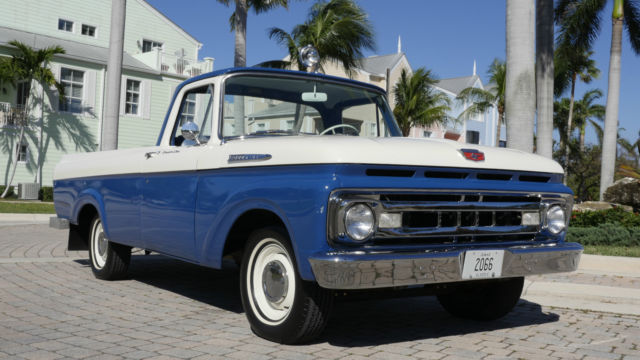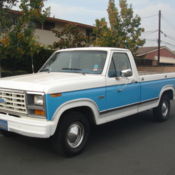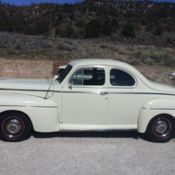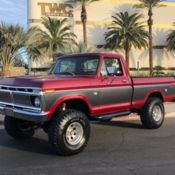1961 FORD F100 RESTORED Y-BLOCK 292 REAL NICE 25K MILES MUST SEE
1961 Ford F-100 CUSTOM
HERE WE GO FOLKS !!ANOTHER GREAT DEAL WE ARE MAKING AVAILABLE.OPTIONAL 292 Y-BLOCK MOTOR
THIS IS ONE OF THE NICEST F100 TRUCKS ON THE MARKET1961 FORD LONG BED PICKUPNO RUST ON OR UNDER THE TRUCKTHE STEERING IS TIGHT, OES NOT PULLBRAKES ARE GOOD AND ALSO DO NOT PULLTHE ORIGINAL ENGINE STARTS RIGHT UP EACH TIMEDOES NOT SMOKE, O UNUSUAL NOISESI HAVE DRIVEN THIS TRUCK UP TO 60 MPH, ND IT DRIVES GREATTHE TRUCK HAS BEEN REPAINTED, T IS A VERY PROFESSIONAL JOB AND LOOKS GREATREADY FOR YOUR LOCAL CAR SHOWTHE SUSPENSION HAS BEEN REBUILT TO ORIGINAL SPECSBRAKES ARE EXCELLENTDRIVE TRAIN IS TIGHT, LUTCH AND TRANSMISSION ARE SMOOTHTIRES AND WHEELS ARE EXCELLENTTHE INTERIOR HAS BEEN COMPLETELY REDONE ALONG WITH THE DASH, EATS,AND DOOR PANELSEVERYTHING LOOKS FABULOUSCALL ME DIRECT TO SEE, EST DRIVE OR HAVE ANY QUESTIONS.WE ARE A FLORIDA FAMILY SMALL INTERNET DEALERWE SPECIALIZE IN CLASSICS, OATS AND MOTORCYCLESCALL ME ANYTIME, Y NAME IS JACK AND CAN BE REACHED AT 954 520-9751
By Wes Grueninger for PickupTrucks.com
The design of Ford's F-Series is like a taproot, ith each previous generation forming the basis for the growth of the next. Engines, ransmissions and chassis carry over from one generation to the next, ith major redesigns often happening independently of body styles.
Some features, ike the Twin I-Beam front suspension, ould prove to be central to the continued growth of the brand, panning generations from its introduction in 1965 up through today's two-wheel drive Super Duty. Others, uch as the 3.8-liter Essex V-6 launched in 1982, roved to be offshoot tendrils that lasted less than two years.
Then there are some designs that were so out there, o far ahead of their time, o far ahead of the technology needed to make them work properly that it's hard to believe Ford's engineers managed to get them off the ground. Such designs were the one-piece unibody trucks, vailable on the fourth-generation F-100 and F-250, hat would leave some serious cricks and crags in the F-Series' lineage.
Ford originally referred to them as the “integrated pickup,” but calling them “unibodies” is a bit of a misnomer. The nickname derives from the fact that the cab and box are one continuous piece, ith no gap between them. The same stamping forming the back of the cab was also the leading edge of the bed, nd the single-wall bed sides were spot-welded directly to the door sills. The one-piece body was then set atop a traditional frame-style chassis, aking the unibody pickup more similar to a body-on-frame car than a true unitized assembly, ike the contemporaryFalcon-based Ranchero.
1961 Ford F-100 (top and above) photo courtesy of Ford Motor CompanyWhy Ford chose such a risky design direction for its flagship pickup is the result of several factors. There's the ever-present matter of cost – the unibody truck required fewer stampings, ewer welds and a less complicated path through the assembly plant's paint shop. Then there was packaging. Eliminating the gap between the bed and the cab allowed a larger cargo loading area, nd promotional material bragged that the 1961 truck had 16 percent more load space than its predecessor.
But most important was Ford's desire to create a paradigm-shifting breakthrough. The company saw the market for pickup truck buyers expanding from farmers and tradesmen to include suburbanites who needed more versatility than what a station wagon could offer. Those buyers demanded the slickness of post-Atomic Age industrial design. By making the new F-Series more stylish and genteel, ord hoped to reach out to previously untapped markets.
Advertisements focused on the new F-Series' carlike ride and refined interior, ith “five inches of foam” on the seat and 23 pounds of sound deadening in each cab. The cab doors were designed to swing wide, nd the knee-busting “dog leg” required on older trucks with wraparound windshields was eliminated. Dealer-installed “Polar-Aire” air conditioning was available, s was a large rear window that curved around the B-pillars and offered a panoramic view out of the cab.
At the same time, ord couldn't alienate its existing base of F-Series buyers, any of whom ordered stripped-down trucks as farm vehicles or no-frills delivery beaters. Seat belts, irrors and even rear bumpers were optional.
1962 Ford F-100 photo courtesy of Ford Motor CompanyThe powertrain options remained tried and true. Standard was the 223-cubic-inch, 37-horsepower straight-six that Ford sold under the name Mileage Maker. Optional was a 292-cubic-inch, 86-hp V-8 that, wing to its deep skirting, arned the nickname “Y-block.” Three- and four-speed manuals were available, s was a lone automatic option, he three-speed Ford-O-Matic.
Production was set for 12 U.S. assembly plants, s well as Ford's Oakville, ntario, lant, hich would build both the F-Series and a nearly identical Mercury M-Series to be sold at Canadian Lincoln-Mercury-Meteor dealerships. Other factories in Argentina and Mexico would come online during the production run.
So confident was Ford in its new unibody trucks that, hen they were introduced in 1961, he unibody was the model used for short- and long-bed F-100s and F-250s. These “styleside” models, s Ford called them, ere available only in two-wheel drive. Buyers who wanted a step-side cargo box could opt for a “flareside” model that used a separate cab and bed.
Four-wheel-drive trucks, n either styleside or flareside models, lso retained a classic cab-and-bed design, stensibly because the unibody couldn't withstand the abusive twisting and flexing that four-wheel-drive trucks were subjected to. Those concerns would prove to have some merit, nd would ultimately be the unibody's downfall.
Shortly after the trucks went on sale, uyers discovered that putting heavy cargo in the unibody trucks could cause the one-piece body to flex with interesting consequences. Stories percolating through the Internet tell of unibody owners who would load their trucks, nly to discover that the sills had distorted enough to jam the doors shut. Yet others tell tales of having a fully laden truck twist badly enough to pop a door open when crossing railroad tracks. Age and corrosion only exacerbated issues as the load-bearing bodies began to perforate and rust.
Get your own valid XHTML YouTube embed code
Get your own valid XHTML YouTube embed code
- Condition: Used
- Make: Ford
- Model: F-100
- SubModel: CUSTOM
- Type: TRUCK
- Trim: CLASSIC CUSTOM
- Year: 1961
- Mileage: 25,890
- VIN: F100R130440
- Color: BLUE
- Engine size: 292
- Number of cylinders: 8
- Fuel: Gasoline
- Transmission: Manual
- Drive type: RWD
- Interior color: BLUE
- Vehicle Title: Clear Want to buy? Contact seller!










